Nowadays virtually every aeroplane has one pair of wings; they are monoplanes. Biplanes with two pairs of wings were very common in their day, and at least one triplane- the Fokker DR1 with three pairs of wings- became famous during the First World War as the machine flown by Baron von Richthoven. But things did not stop there; at the time writing the record appears to be 200 wings. Yes, two hundred. Obviously this is something that needs investigation.
There is a Wikipedia multiplane page dedicated to aero planes with more wings than a triplane.

THE AERODYNAMICS
Before and during the First World War two major discoveries in aerodynamics were made, that are highly relevant to examining early aeroplanes:
Aspect ratio. The aspect ratio of a wing is the ratio between its span (the distance between the wingtips) and the chord. (The distance from the leading edge to the trailing edge) A high aspect ratio, ie wings that have a span large with respect to the chord, are more efficient as the lift-to-drag ratio increases. Wikipedia gives a very good introduction. The importance of aspect ratio was recognised by the Wright brothers Their 1900 and 1901 gliders had low aspect ratio wingsof 3.4 and 3.3 respectively. From their wind tunnel data, the Wrights discovered that a high aspect ratio wing generated more lift and less drag than a low aspect ratio. The aspect ratio for their next glider in 1902 was 6.7, and it was very successful. The Wright Flyer had an aspect ratio of 6.4; modern light aircraft have an aspect ratio of around 7.
Aerofoil thickness. Early aero planes had thin wing sections as this was believed (incorrectly) to give good lift/drag ratios. Thin airfoils showed “thin airfoil stall” at low angles of attack, due to the separation of the flow over the top surface of the thin airfoil, creating much higher drag and a loss of lift. Under the same conditions, thicker airfoils did not suffer flow separation until much higher angles of attack, hence producing more lift and less drag. This was discovered by German engineers, and thick airfoils were employed on the Fokker Triplane and the Fokker D-7 from late 1917 onwards. These machines could climb faster and maneuver more sharply than aeroplanes with thin airfoils; the Fokker D-7 was one of the most effective fighters of the First World War.

THE TRIPLANES: THREE PAIRS OF WINGS
We start with triplanes because most people are only aware of one- the Fokker DR1. In fact there were many, though it was never as popular a configuration as the biplane. There is a List of Triplanes in Wikipedia which gives 123 designs, though not all of these were flown, and only a few entered any sort of quantity production.
Triplanes have an excellent Wikipedia page of their own.
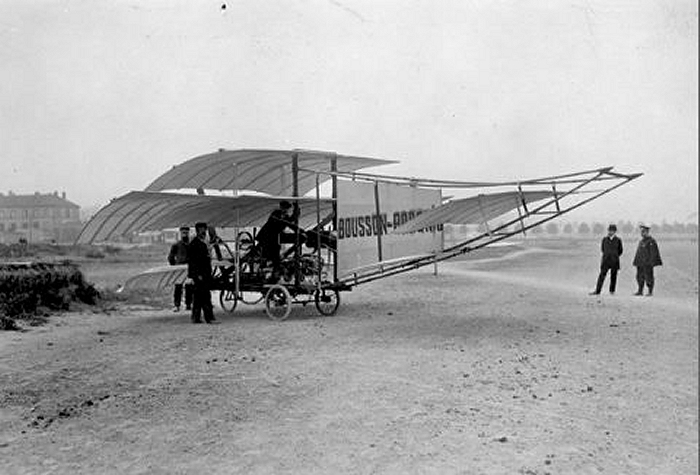
| Left: The Bousson-Borgnis Triplane: 1908
The Bousson-Borgnis Triplane was built by Firmin Bousson wand brothers Achille and Paul Borgnis from 1908 to 1909; it was named the "Auto-Aviateur,"
The trio had built their first (and unsuccessful) machine in 1901. The machine was powered by a 34 h.p Buchet engine, which drove the four-blade pusher propellor by belt and pulley. It does not appear to have actually flown. It is presumed that the three people in the image are M. Bousson (left) and the brothers Borgnis.
As is often the case in aeroplanes of this era, it is hard to work out what counts as a wing and what is just a control surface. There are two definite wings in the centre, and at the front (on the right) the upper surface is a fixed wing; below this are two smaller surfaces only just visible as they are edge-on and these are presumably the elevators. There is another surface at the rear, which may or may not count as a wing. The sheet carrying the Bousson-Borgnis name is a vertical rudder set ahead of the pilot.
The design is a tail-first configuration, otherwise called a canard. (duck)
|
|
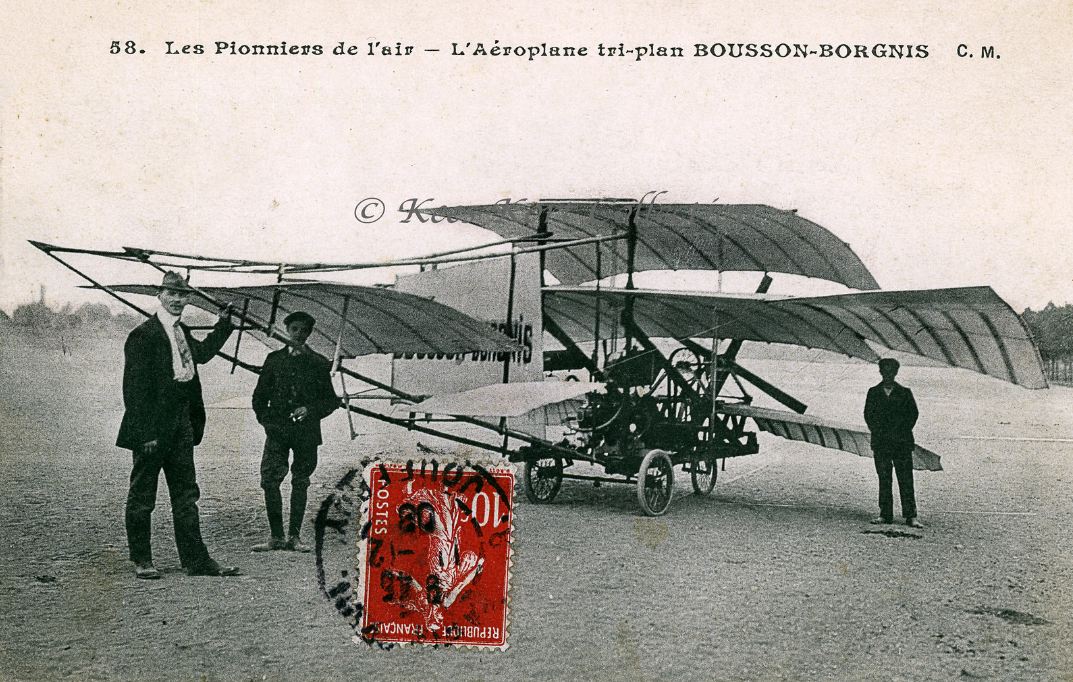
| Left: The Bousson-Borgnis Triplane: 1908
This gives a better view of the two smaller surfaces at the front. The location is probably the field of Issy-les-Moulineaux near Paris, which often used to test early aeroplane designs.
|
|
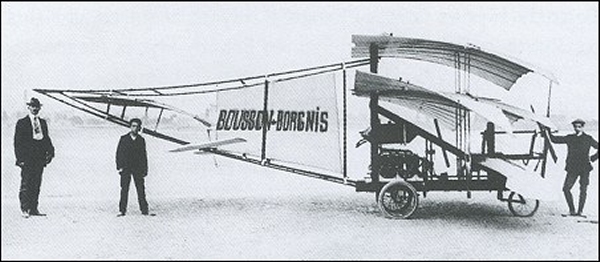
| Left: The Bousson-Borgnis Triplane: 1908
This picture shows the same three men as the one above. It makes it clear that the machine had a tricycle undercarriage.
|
|

| Left: The Dufaux triplane or hexaplane: 1908
The Dufaux triplane was a experimental aircraft built in Switzerland in 1908 by Armand and Henri Dufaux. It had two sets of triplane wings, making it technically a hexaplane, but it is always referred to as a triplane.
It had the very advanced feature of an engine and propeller mounted in the centre of the airframe, which could be tilted through 180 degrees to give forward thrust, upward lift, or reverse braking. However it never came near to leaving the ground and the project was abandoned in 1909. Note the extreme dihedral on both sets of wings, and the tail.
The Dufaux triplane has a Wikipedia page.
|
|

| Left: The Dufaux triplane triplane: 1908
Unfortunately this shows little more of the engine installation.
|
|
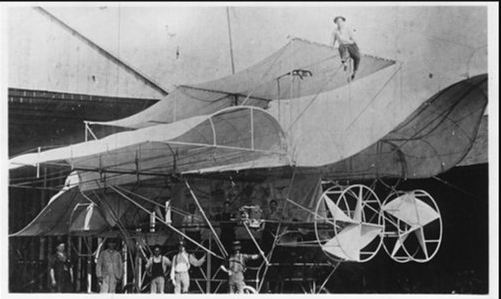
| Left: The Call Mayfly triplane: 1908
This machine was built by a New York lawyer, author and lecturer named Henry Laurens Call of Girard, Kansas. This is another design where the number of wings is hard to be sure of; there are three stringly-curved wings at the middle level, with two sort-of-wings at the top level. Below the middle wings some picture show what might be wings or rudders; the design went through several iterations.
The machine was powered by two 20HP Curtiss engines driving crude 4-blade tractor propellors. It spanned 41 feet, and weighed 3,000 pounds. It was hopelessly underpowered (and there were many other issues, such as the lack of proper aerofoils) and it never flew.
There is more information here.
|
|
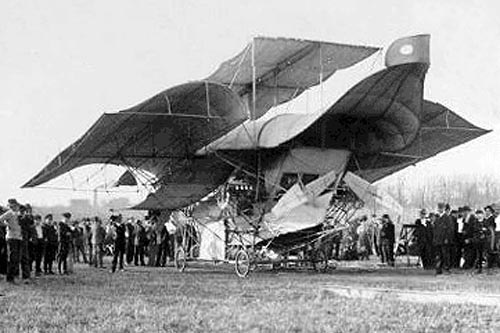
| Left: The Call Mayfly: 1908
The Mayfly (there's a joke in there somewhere) regularly wins "Ugliest Aeroplane" competitions, though the competition is strong.
|
|
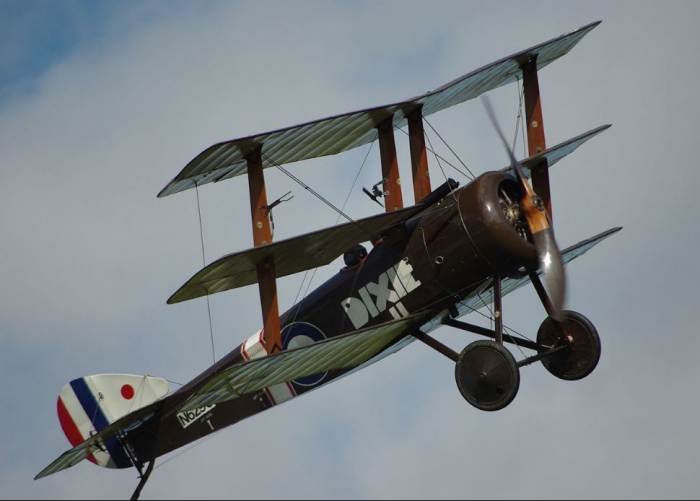
| Left: The British Sopwith triplane: 1917
The Sopwith Triplane did not have a particularly strong airframe, and you could literally pull the wings off it by pulling out of a relatively modest dive.
The Sopwith triplane has a Wikipedia page. There is more information here.
|
|
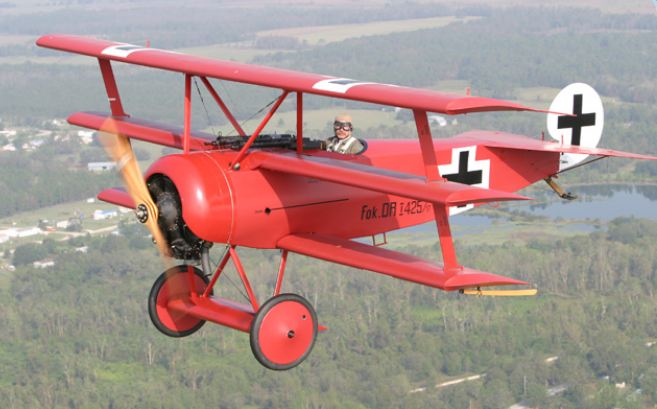
| Left: The German Fokker DR-1 triplane: 1917
This is the most famous triplane, as flown by Baron von Richthoven; it is in fact the only one most people have heard of, but the truth is it was a reaction to the British Sopwith Triplane, which began operations in early 1917. The Fokker triplane served from the autumn of 1917 until the Armistice in November 1918. The DR-1 was slower than most of its contemporary rivals but it had efficient thick wings which gave it an exceptional rate of climb and a very tight turning circle, to allow it to compete with the Sopwith triplane. Some 300 or more were built but none of the original planes have survived; there are a number of replicas.
So far as is currently known the Sopwith triplane was withdrawn from service before the Fokker appeared, and there is no record of the two types fighting each other.
There is more info here.
|
|

THE QUADRUPLANES: FOUR PAIRS OF WINGS
Quadruplanes do not have a Wikipedia page of their own, but a sub-section of the Wikipedia multiplanes article; see Quadruplanes.

| Left: The Seddon biplane/quadruplane: 1908
Like several early aeroplanes, this could be regarded as a tandem biplane or a quadruplane. It had two sets of biplane wings, the forward set being wider than the rear one. It was powered by two 65 HP NEC water-cooled engines, each driving a tractor propellor between the wings. It did not fly when tested,
There is a Wikipedia page.
|
|
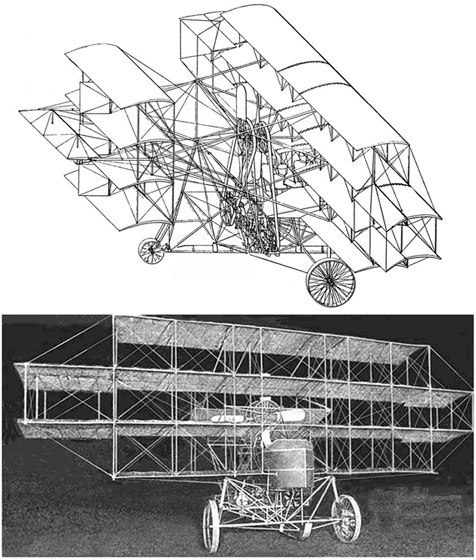
| Left: The Jacobs quadruplane: 1910-12
The Jacobs Multi-Plane (as it was called) was built by Henry William Jacobs of Atchison KS. It was powered by two pusher propellors working coaxially, each belt-driven by a 35 HP engine (most likely Emersons), later replaced by Jacobs' own motors. The gross weight was 2000 lb. It made its public debut at the New York Exhibition of 1910, and was thus described 20 years later in a retrospective: "Optimistic reports credited it with flight performances that would be marvelous even now (1930), but verification was inadequate."
From Alan H Jacobs, great-grandson of Henry Jacobs:
"[Jacobs' own motors]... were improved air-cooled engines that my great-grandfather [H W Jacobs] invented to replace the two original underpowered engines [Emersons?] with which the plane flew in 1910, piloted by his younger brother, Frank Jacobs. Frank died in a swimming accident shortly after the first flight, and my great-grandfather was so distressed at being unable to save him that he fell into depression and gave up his airplane invention plans." (Alan H Jacobs 9/5/2006)
This shows that the plane did fly, but perhaps only once. Note the four wings of unequal length. The tail also has four sizable 'wings' so you might classify it as an octaplane.
|
|
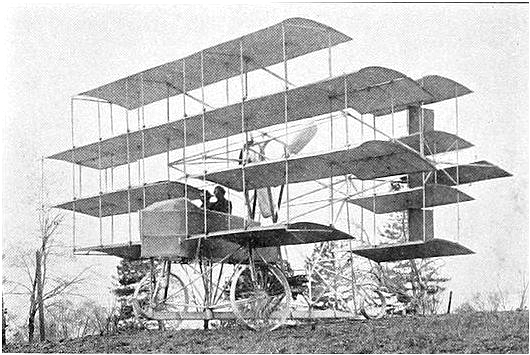
| Left: The Jacobs quadruplane: 1910-12
Another view of the Jacobs quadruplane; note the thin aerofoils which would have been inefficient; it was also a heavy machine weighing a ton. 70 HP from the two engines was quite insufficent to get it into the air.
|
|
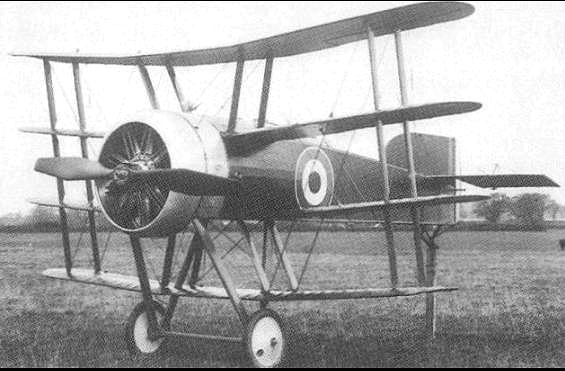
| Left: The Wight quadruplane: 1919?
The Wight {not Wright) Quadruplane was designed in 1916. Remarkably, its wingspan was less than its overall length. It looks like a neat design but the wing design proved inefficient and controllability was poor. In February 1918 it crashed into a cemetery and the project was abandoned.
The Wight Quadruplane has a Wikipedia page.
|
|

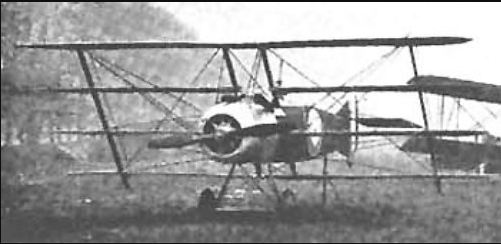
| Left: The Armstrong Whitworth FK10: 1917
The Armstrong Whitworth FK10 was a four-winged aeroplane designed in 1916 by Frederick Koolhoven, a Dutch engineer working in England. The first prototype was called the FK9; it was built and first flown in the summer of 1916. The two-bladed tractor propellor was powered by a 110 HP Clerget 9Z rotary engine.
The production FK10 had only minor modifications. Fifty were ordered but only eight actually built, as the performance proved to be inferior to the Sopwith 1½ Strutter, which was already successfully in service as a two-seat fighter aeroplane. The FK10 never saw operational service.
There is a brief Wikipedia page.
|
|
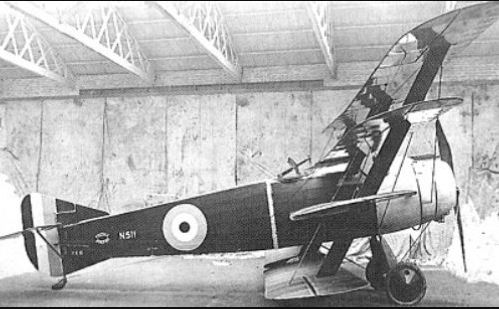
| Left: The Armstrong Whitworth FK10: 1917
Note the significant stagger of the four wings. The Armstrong Whitworth FK10 was a failure because of the excessive drag from the four wings, relative to the available engine power; the FK10 had its engine upgraded to a Clerget 9B rotary giving 130 HP, but it was not enough. Nonetheless it was the only quadraplane which achieved some sort of acceptance.
There is more info here. There is a YouTube video on the FK10, but there are no cine photos of it flying.
|
|
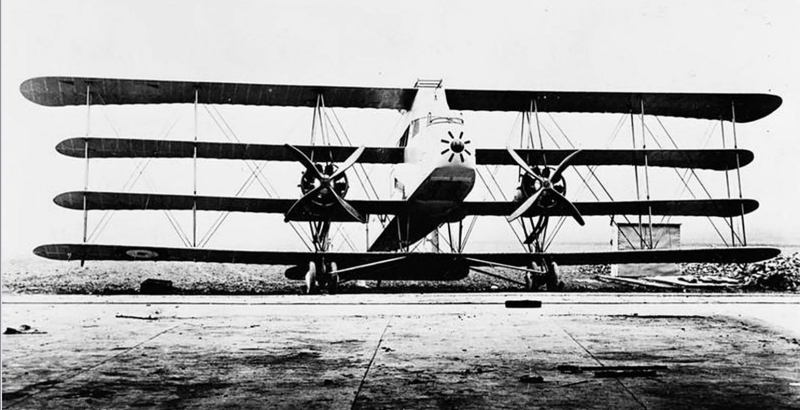
| Left: The Supermarine Nighthawk: 1917
The Supermarine Nighthawk PB 31E was intended to catch Zeppelins. It never did, because it was unable to reach Zeppelin height
It was designed by a young R J Mitchell, who went on to be the chief designer of the rather more successful Spitfire. The Nighthawk was a huge quadruplane, nearly 18 feet high with a wingspan of 60 feet. The four wings provided a large surface area while being relatively light for their structural strength, an idea designed to allow the Nighthawk to intercept German airships. However the plane was distinctly underpowered and took an hour to reach 10,000 feet. Bad enough, but since mid-level Zeppelins commonly flew several thousand feet above that, the plane was quite useless. Maximum speed was 75 mph in theory, but a pitiful 60 mph in reality.
There is more information here.
|
|
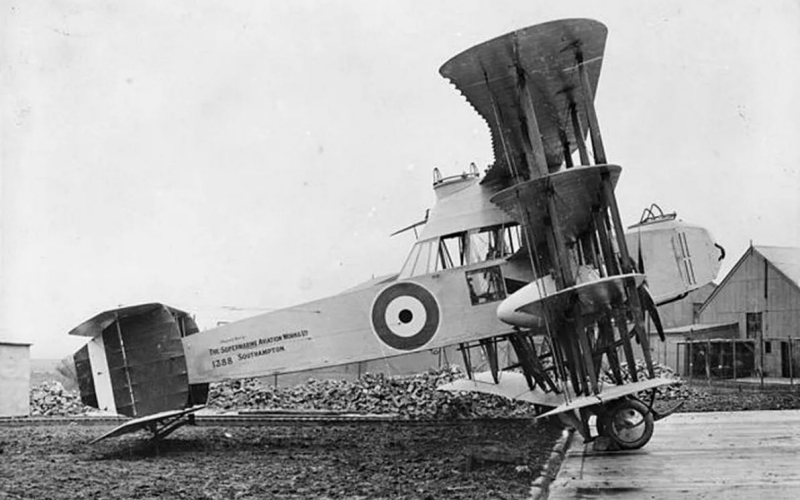
| Left: The Supermarine Nighthawk: 1917
A steerable searchlight, with a separate power supply, (a petrol-electric generator?) was mounted in the plane’s nose; a 37 mm Davis gun on the top was its main armament. There were also two 0.303 Lewis guns. There were four crew members, two of which were gunners.
|
|
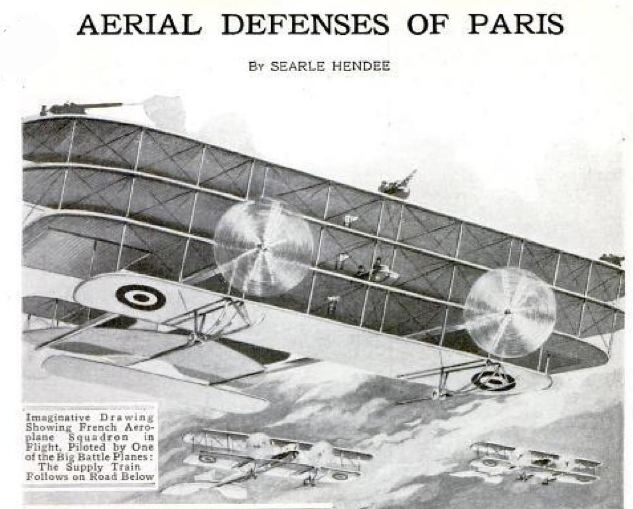
| Left: Quadruplane in Popular Mechanics: 1916
This is described as an "Imaginative Drawing" in an article on the defence of Paris against air attack, but it has an uncanny resemblance to the Supermarine Nighthawk shown just above. It could be purely coincidence, but quadruplanes were highly unusual, and one wonders if some rumours had reached the Popular Mechanics artist. The two outer guns on top of the upper wing were invented by the artist, but the central one was as in the Supermarine Nighthawk.
Source: Popular Mechanics Jan 1916, p33
|
|
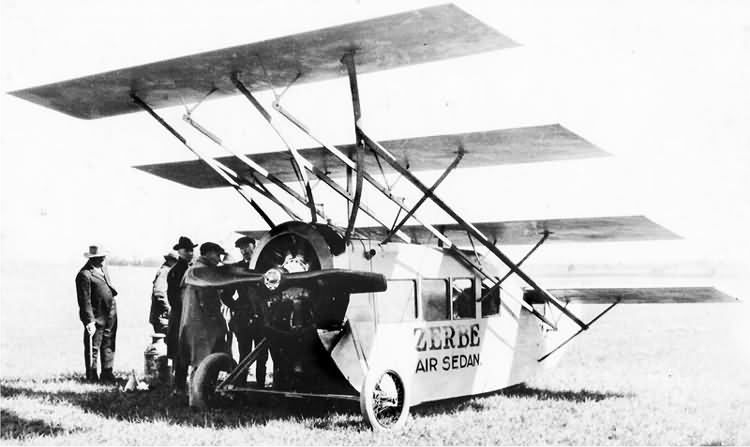
| Left: The Zerbe Air Sedan: 1919?
The Zerbe Air Sedan was a single-engine quadruplane passenger aircraft designed by 'Professor' James Slough Zerbe in the USA in 1918. The machine made one flight in 1921, was damaged during landing, and was subsequently abandoned. There is a Wikipedia page.
"One of the first airliner concepts conceived by Jerome 'James' Slough Zerbe (1849-1921), different sources claim different years: 1909, 1910, 1914, 1918 or 1919. Reports claim the photo shows the quadruplane to be readied for test flight in 1919 at the Fayetteville, Arkansas fair grounds. Reports say the plane took off very quickly, rose to about 100 ft (30 m), flew approximately 1000 ft (300 m), and landed damaging its landing gear. After that Zerbe left town never to be heard of or seen again. What happened to the abandoned damaged plane is unknown."
To me the design of the cowling and propellor design suggest a later date, possibly 1919 but certainly not 1909. Wikipedia says the year of the flight was 1921.
|
|

THE QUINTAPLANES: FIVE PAIRS OF WINGS
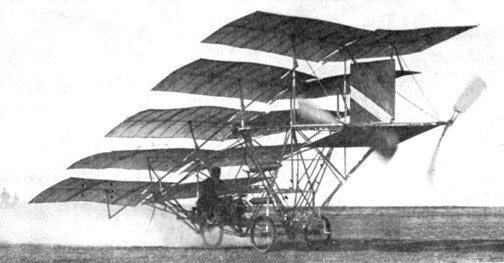
| Left: The Zerbe Quintaplane: 1908?
Before building his Air Sedan (above, 4 wings) Zerbe had also designed not one but three quintaplanes with five staggered wings; see Wikipedia.
There is more information on this quintaplane here,
and also here.
|
|
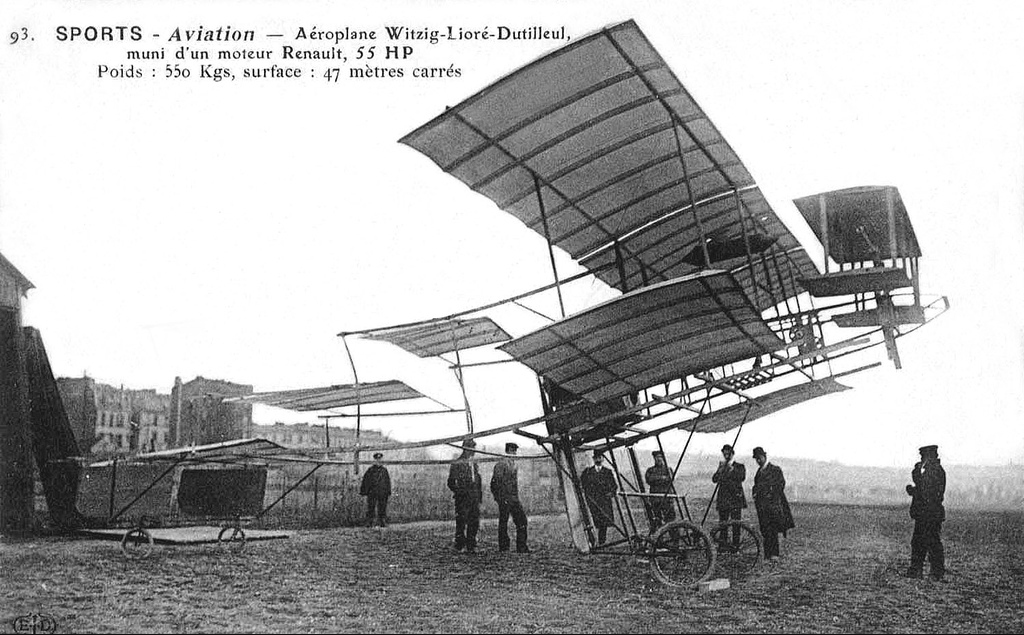
| Left: The Witzig-Liore-Dutilleul quintaplane: 1908
This is a not unusual scenario in the very earliest aeroplanes. You put in a lifting surface (at least, you hope it is a lifting surface) everywhere you can fit one in. This is an early version of the Witzig-Liore-Dutilleul No 1, with the wheels placed too far forward, so the weight of the engine is bending the airframe, and causing the tip of the propellor to rest upon the ground.
It's far from clear if this counts as a quadraplane or a quintaplane.
There was a more conventional Witzig-Liore-Dutilleul No 2 in 1909.
|
|

THE HEXAPLANES: SIX PAIRS OF WINGS
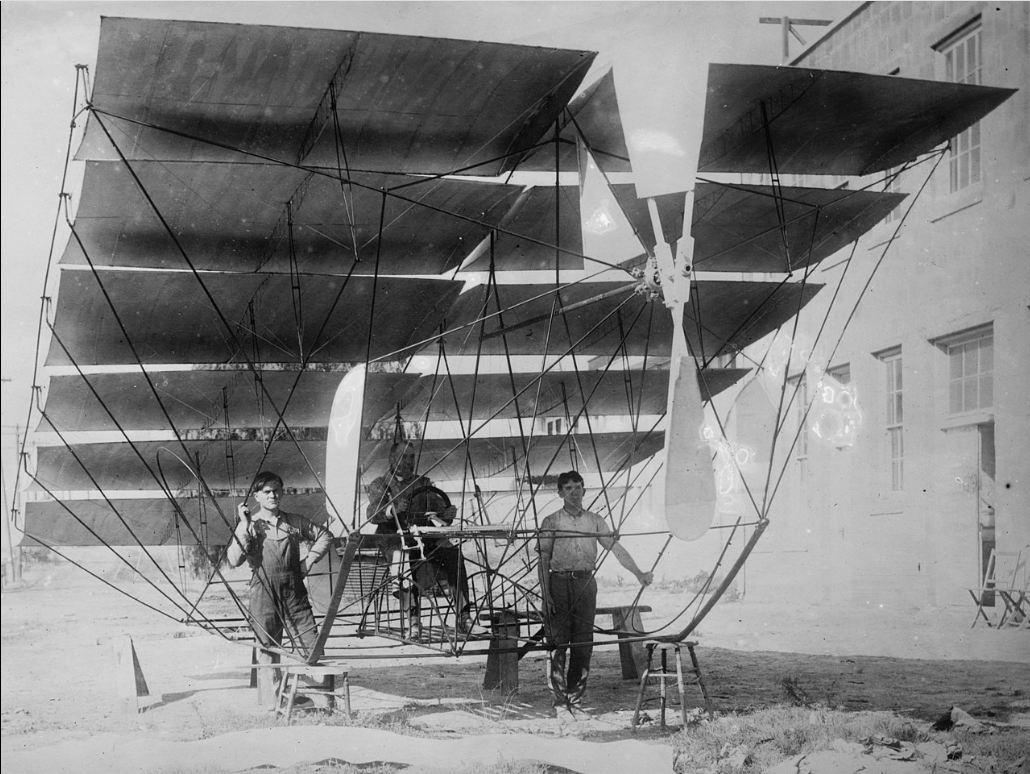
| Left: The Zerbe hexaaplane: 1908
Also previous to his four-winged Air Sedan (see above) Zerbe had designed a hexaplane with six staggered wings; see Wikipedia. It was again a large aeroplane with a single tractor engine. It is unknown if this machine was ever flown and if so what happened. The fact that there actually appears to be no engine installed here suggests it was never completed.
This aeroplane has a Wikipedia page. Note you can call it a hexaplane or a sextuplane.
|
|
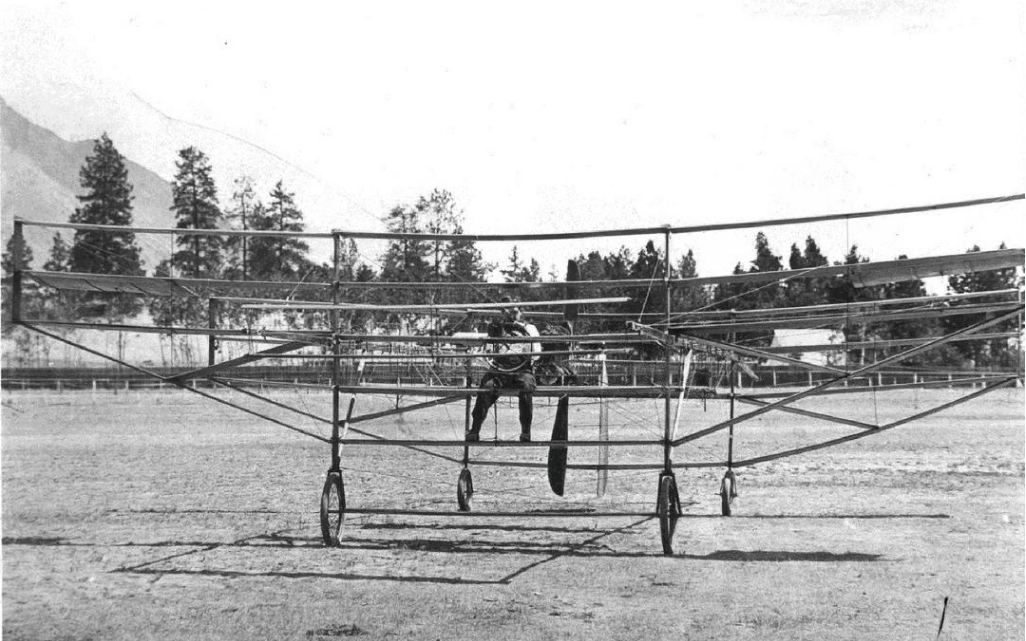
| Left: The Gibson multiplane: 1911
This is the Gibson Multi-Plane, built by William Wallace Gibson after his earlier tandem monoplane 'Twinplane' crashed. The Multi-Plane had two sets of very narrow triplane wings, making it a hexaplane. The forward elevator was altered to a narrow-chord biplane setup. Ailerons were fitted only on the ends of the centre plane of the front set of wings. A centrally mounted 40 HP engine (that used in the Twinplane) drove a pusher propellor.
The hexaplane appears to have made several successful flights, but it crashed on 11 August 1911, and was not rebuilt.
There is more information here.
|
|
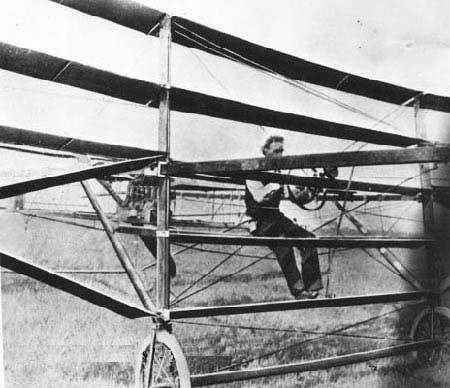
| Left: The Gibson multiplane: 1911
William Wallace Gibson at the controls. The three upper structures are the front set of wings.
|
|

| Left: The Howard Huntington Multiplane: 1913
This multiwing monstrosity was constructed in Queens, New York between 1912 and 1913 by Howard Huntington. It had six wings in line, making the fuselage very long. The wings are thin-section and do not look as though they would provide much lift.
That's Mr Huntingdon standing in front of the Multiplane.
|
|
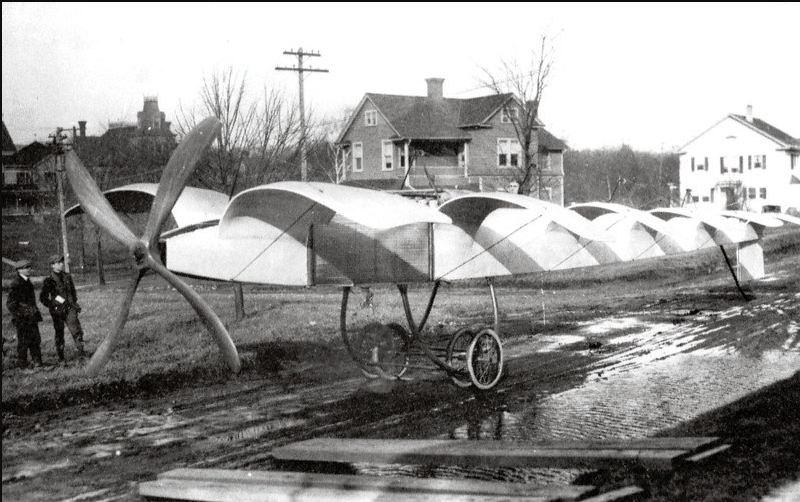
| Left: The Howard Huntington Multiplane: 1913
There is no record of the multiplane flying, despite the purposeful look of the propellor in this picture.
In June of 1914 Huntington constructed a single wing version of the multiplane, which was called the Huntington Clam. That did fly.
|
|
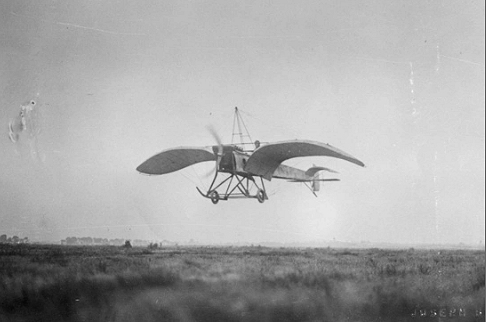
| Left: The Howard Huntington Clam: 1914
The Huntington Clam in flight
|
|

THE SEPTAPLANES: SEVEN PAIRS OF WINGS
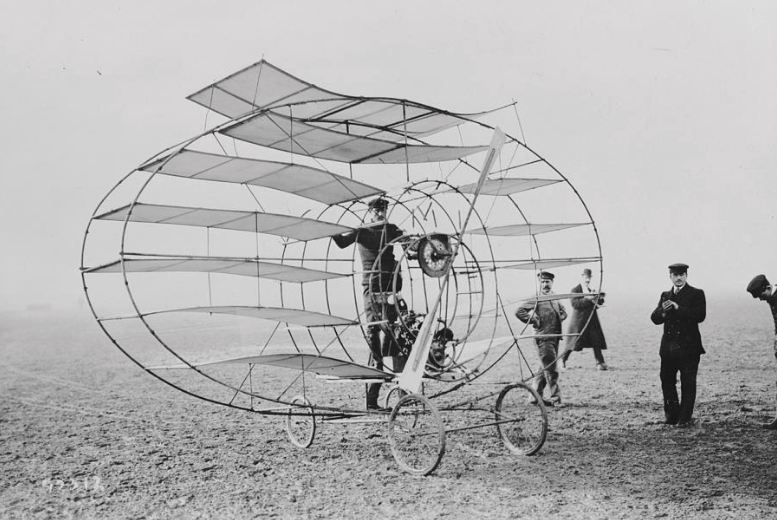
| Left: The Marquis multiplane: 1907
This is a well-known photograph, but technical details are lacking. It was built in 1907 by the Marquis d'Ecquevilly, but never flew. It was destroyed in a fire in June 1908, and d'Ecquevilly built a new version design with fifty (yes, fifty) pairs of wings instead of six; this never flew either.
The wings are simple flat plates, which make a very poor aerofoil. There is also no visible means of control, not even a rudder; it could not have flown successfully. The oval hoops were 16 feet across and the engine was a 10 HP Buchet, geared down by a belt and pulleys. The machine was destroyed in a fire, and the Marquis went on to design a multiplane with 25 pairs of wings.
There is more information here. The Marquis multiplane is not mentioned in the Wikipedia multiplane article.
Photo location: Arles?
|
|
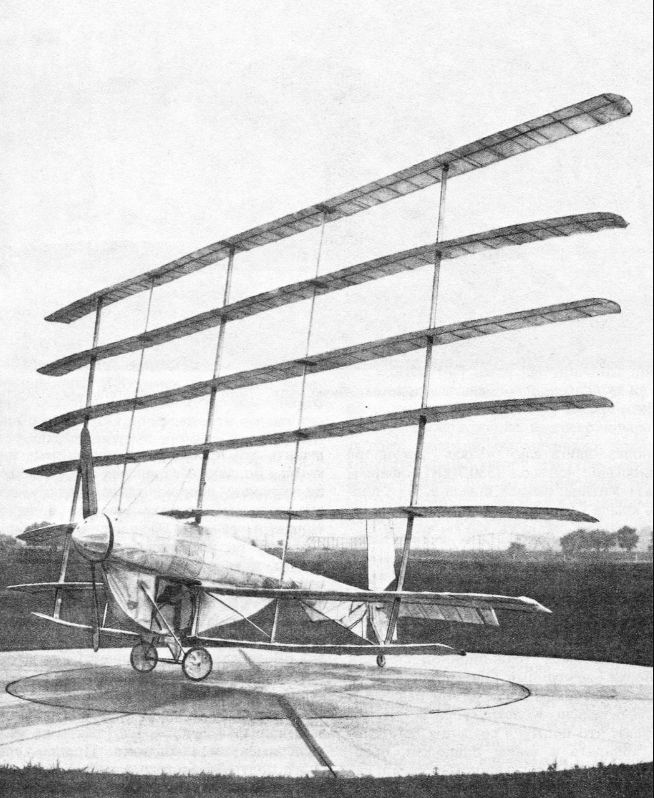
| Left: The Gerhardt Cycleplane: 1908
The seven-winged Gerhardt Cycleplane was developed in 1923 by Dr. William F Gerhardt, the head of the Aeronautical Engineering Department at the University of Michigan. It had seven wings of very high aspect ratio, presumably to minimise induced drag. The aerofoils appear to be of very thin section and therefore inefficient. The aircraft first flight was made on July 1923. In the first flight tests, an automobile towed the Cycleplane into the air and released it. The only human-powered takeoff of the Cycleplane was a short hop of 20 feet, rising only two feet.
The Cycleplane came to an inglorious end, collapsing into a pile of wreckage during a test run. The cine film of the accident is well-known and you can see it on YouTube.
There is a Wikipedia page.
|
|
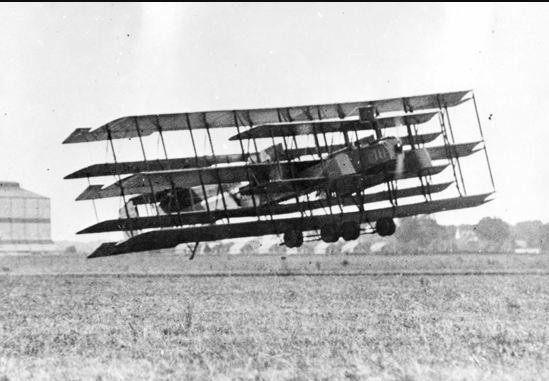
| Left: The Johns Multiplane: 1920
The seven-winged Johns Multiplane staggers into the air. It was powered by three Liberty engines; one driving a tractor propellor in the nose, and two in wing nacelles driving pusher props. Gun positions can be seen at the front of the nacelles.
In 1916 US patent 1,365,995 was issued to Charles Hermann of the American Multiplane Company on a new aircraft that had been designed by Herbert Johns, also of the AMC. The first (unsuccessful) attempt at flight was in April 1920.
There is a brief Wikipedia page.
|
|
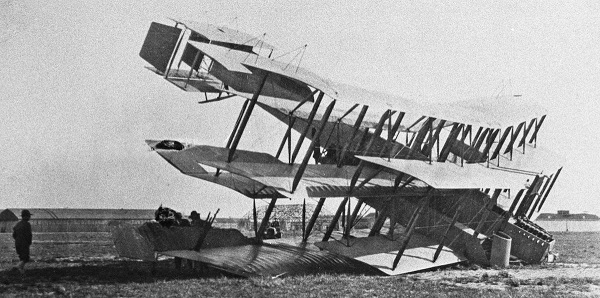
| Left: The Johns Multiplane: 1920
The end of the first flight of the Johns Multiplane. It proved to be far too tail-heavy, but somehow crashed on its nose.
|
|
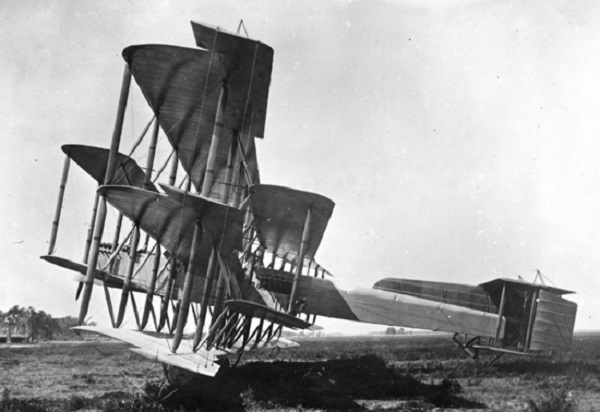
| Left: The Johns Multiplane: 1920
The next flight, after repairs and modifications, took place on July 1920. This is believed to have only been for 100 yards or so before the machine returned to the ground- it is not currently clear if it crashed. It was clear the design was hopeless and the machine was scrapped in September 1920.
This picture gives a good view of how the Multiplane was effectively a triplane with biplanes grafted on front and back of the three main wings. The main triplane was fitted with six ailerons.
|
|

THE OCTAPLANES: EIGHT PAIRS OF WINGS
Typing 'octaplanes' into Google did not at first yield anything useful; mainly imaginary aircraft and eight-rotor drones.
But there was this:
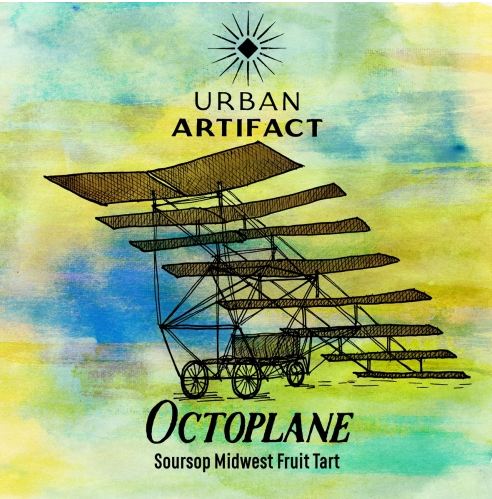
| Left: Imaginary octoplane: date unknown
This is not an advertisment for a fruit tart rather than an aeroplane. Octoplane is actually a 7.8% sour beer brewed in Cincinnati, Ohio; not my style of beer. The aeroplane design is clearly taken from Zebbe's quintaplane above, though it is not clear what is its relevance.
No engine is fitted.
|
|

THE NONAPLANES: NINE PAIRS OF WINGS
This is actually an easy one. The Caproni Ca.60 Transaereo, sometimes referred to as the Noviplano, (nine-wing) famously had three sets of three wings- a sort of triple-triplane.
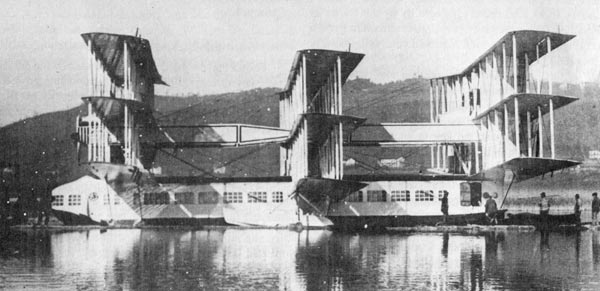
| Left: The Caproni Ca60: 1921
The Ca 60 was the brainchild of the Italian aeroplane designer Gianni Caproni. One was built, and was tested on Lake Maggiore in 1921, making a short maiden flight. Its second flight was on 4th March; shortly after takeoff, it crashed onto the water and broke up upon impact. It was not rebuilt.
The Ca 60 has a very good Wikipedia page.
|
|

THE DECAPLANES: TEN PAIRS OF WINGS
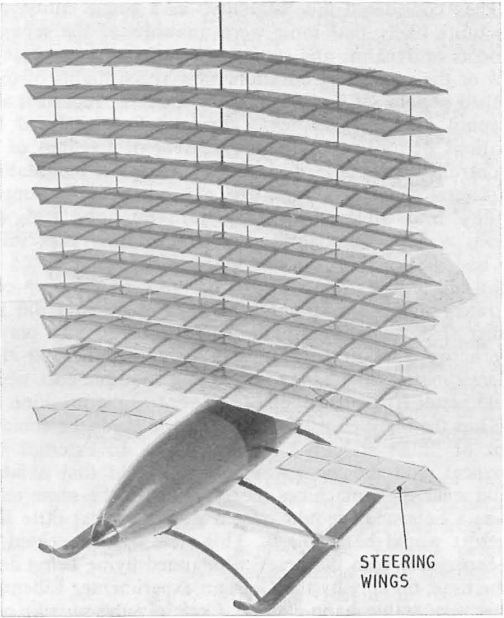
| Left: The Decaplane model of Colonel Renard: 1873
In 1873, the Frenchman, Colonel Charles Renard tested from the St.-Eloi Tower near Arras an unmanned decaplane glider, incorporating an automatic device intended to improving the machine’s directional stability.
The decaplane test was unsuccessful. It descended from the tower in a spiral dive and although the stabilising wings appeared to operate as planned, they were clearly unable to counteract the effect of the powerful lateral instability which was inherent in the design. (There appears to be anhedral rather than dihedral on all ten wings) There is no tail surface so pitch stability might also have been problematic.
The automatic device was a transverse pendulum operating differentially a pair of small rotatable wings. Colonel Renard’s idea was that “if the aircraft leaned to one side at the beginning of a turn, the action of these small wings, one rising inside the turn and the other descending on the outside of the turn, would straighten the aircraft”. Renard’s machine was very probably the first attempt to use an active stability device on an aeroplane; this was a bit premature as a workable aeroplane was still thirty years off.
See R.W. Howard, "Automatic Flight Controls in Fixed Wing Aircraft, The First 100 Years," The Aeronautical Journal, November 1973, pp. 533-562. There are no further details of the aeroplane.
You could argue that this is eleven wings, if you count the 'steering wings' at the bottom.
Image from ICAS Paper 80 Impact of Advanced Control Concepts on Aircraft Design by Dr Herman A Rediess, NASA
It has been amply proven that you can make a model decaplane that flies successfully, See
here and here.
|
|

THE MULTIPLANES: MORE THAN TEN WINGS
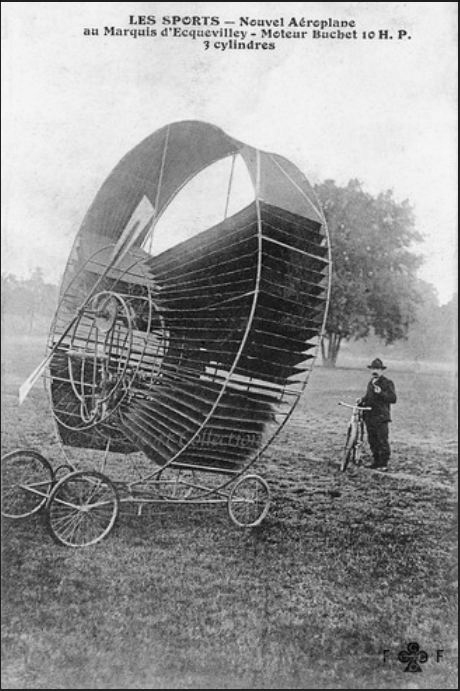
| Left: The Marquis multiplane: 1908
It was built in 1907 by the Marquis d'Ecquevilly, after his earlier septaplane was destroyed in a fire. There are allegedly 50 wings on this machine, but that actually means 25 pairs of wings. The wings are so close together that it seems highly unlikely they could have operated properly. In any case the wings appear to be simple flat plates (ie un-cambered) and so would not be effective.
Note Monsieur Dupont looking on.
|
|

| Left: The Phillips multiplane of 1893
Horatio Phillips is famous for producing venetian-blind aeroplanes; however this does not mean he was a lone nutter. He showed that aerofoils should be cambered rather than flat planes. His 1893 Flying Machine had 50 wings and used his patented "double-surface airfoils" in such a way as to produce an effective aspect ratio of 1:152, providing a lot of lift. It was a test vehicle, and not designed to be manned.
Each wing was twenty-two feet (6.7 m) long and 1.5 inches (3.8 cm) wide, and was spaced two inches from the next wing.
The test vehicle had a two-blade propellor turning at 400 rpm, powered by a coal-fired steam engine. It could lift its own weight plus 72 pounds (totaling 402 pounds) some three feet, at a speed of about 40 mph. Highly promising results.
There is more information here.
|
|
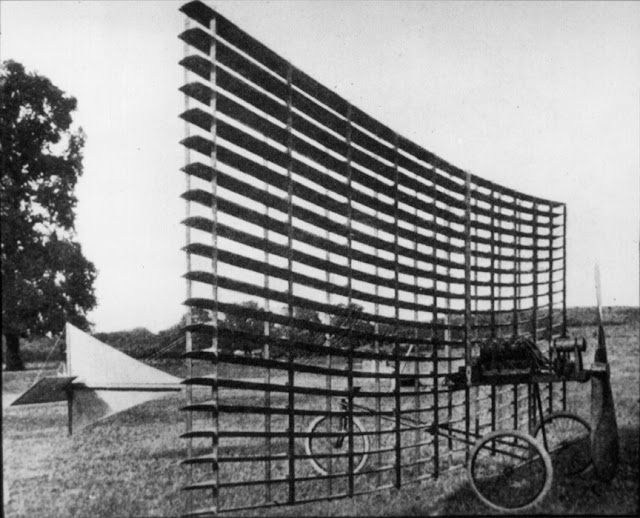
| Left: The Phillips multiplane of 1904
Phillip's 1904 Multiplane was a development of the 1893 test vehicle designed be flown by a pilot. It had 21 wings, with a tail added for stability, but it was unable to achieve sustained flight. Its longest flight was 50 ft (15 metres). Whether it would have been controllable on a longer flight is very doubtful; the tail appears to have elevators but there is no obvious rudder. Nor do there appear to be ailerons, which might be quite a challenge to install with all those wings. It was reported that longitudinal stability was poor.
Meanwhile the Wright brothers had made their first successful flights on 17 December 1903.
There is more information in Wikipedia.
|
|
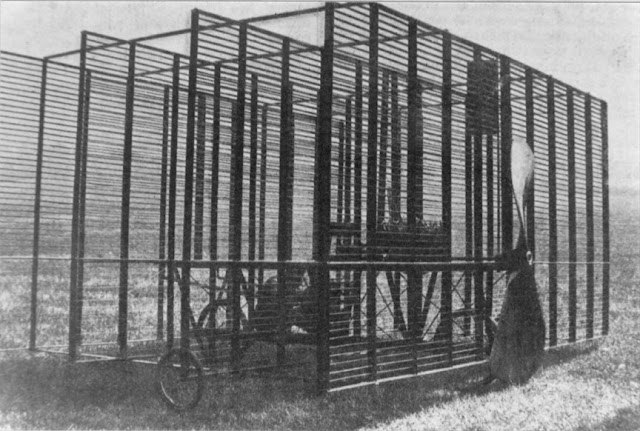
| Left: The Phillips multiplane of 1907
Phillips 1907 multiplane had four banks of 50 wings each, making a grand total of 200 wings, and an 8 foot propeller. It was in this machine that Phillips made a powered, although uncontrolled, flight of about 500 feet.
From a contemporary article:
"Then in 1907 a new machine was tested, in which four sets of frames, carrying similar sets of slat "sustainers" were inserted, and with this arrangement the longitudinal stability was found to be very satisfactory. The whole apparatus, with the operator, weighed 650 pounds. It flew about 200 yards when driven by a motor of 20 to 22 h.p. at 30 miles an hour, thus exhibiting a lift of about 32 pounds per HP, while it will be remembered that the aeroplane of Wright Brothers exhibits a lifting capacity of 50 pounds to the HP."
|
This was the first successful flight by a manned and powered heavier-than-air aircraft in the United Kingdom. However, by 1907 Wright-type aeroplanes had made great progress, and Phillips abandoned his efforts.
There is yet more information here.
|
|

| Left: The Roshon Multiplane: 1908
The Roshon Multiplane had, according to various accounts, either 7 or 8 pairs of wings. However, looking at the photograph there seem to be five wings in the lower section, and two sets of five wings in the upper section,making a total of 15 wings. It is not clear if the rows of curved things count as wings or what. It was made of fabric on wood with a metal tube frame, mounted on four wheels.
It did not fly. It was International Aviation Competition in St. Louis in October 1907,
John William Roshon was a photographer by occupation. He took out US patent 868,488 for a flying machine.
Note the crude propellor fitted.
|
|














































